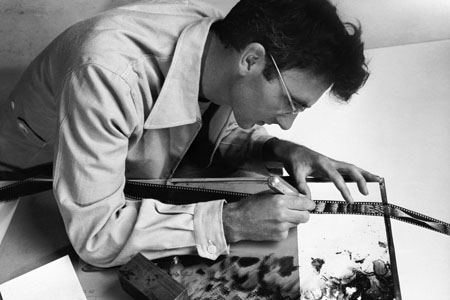Drawn-on-film animation, also known as direct animation, refers to a technique where images are drawn directly onto film strips, creating “camera-less” film. Instead of photographing the frames individually to create a film, animators can employ various techniques directly on the film strip, including painting, stamping, etching, and punching.

There are three main ways of producing direct animation: i) adding images to blank (transparent) film stock, ii) scratching or etching on developed (black) film, and iii) placing objects on undeveloped film stock and exposing it to light. Animators may also use found footage in their films, painting over or scratching into the existing images to create new meaning.
One of the earliest examples of this technique is Len Lye’s A Colour Box, which was made in 1935. In this film, he uses textures and shapes in bright colours to create a mesmerising collection of abstract movement. This was one of the first direct animations that was screened to the public, and had a large impact on audiences, especially as colour film was still considered novelty at the time.
Norman McLaren also created multiple films using the direct animation technique, including Boogie-Doodle (1941) and Hen Hop (1942). His animations showcased how characters and narratives can still be depicted despite the small scale of 35mm film, creating dancing creatures and animals with merely a regular pen and ink.
Another animated short that uses the direct animation technique is Two Sisters (1991) by Caroline Leaf. Etched into tinted 70mm film, the film takes advantage of its medium to explore the contrast of light and dark, and emphasise on these themes within the plot.
Another interesting aspect about direct animation on 35mm film is the existence of the optical soundtrack. This allows sound to be generated by projecting light through the film and detecting the intensity of the brightness. This brightness value can then be converted into changes in volume and pitch2. Because of this, animators have the option to create synthetic and experimental sound to accompany their images by drawing in this section of the film.
I’m fascinated by this method of animation because of the tactile nature of the medium, where we are essentially skipping the “middleman” in the animation process and directly creating images on the method of distribution. While it appears to place many limitations on the animator, especially in terms of what they are able to create in such a small medium, there are many creative ways that artists have used the nature of the medium to its strength and created both visually and narratively compelling films. I’m also very curious about how found footage can be incorporated into drawn-on-film animation, and would be interested in exploring this in my work!
Sources:
1Norman McLaren (2021), CCCB <https://www.cccb.org/en/participants/file/norman-mclaren/11677>[accessed 5 March 2024].
2Sound ([n.d.]), University of Wollongong < http://unimovies.uow.edu.au/sound/sound.html> [accessed 5 March 2024].